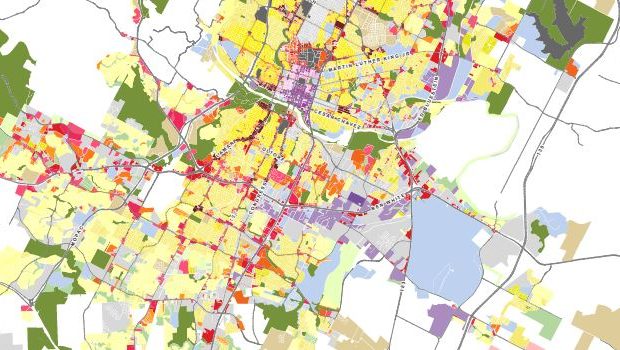CodeNEXT: The devil is in the details
Thursday, April 26, 2018 by
Jo Clifton As the development process for the land use code rewrite known as CodeNEXT has progressed, a common refrain heard from critics is that it will drastically alter Austin’s existing zoning. However, at Tuesday’s work session, Planning and Zoning Department Director Greg Guernsey emphasized to City Council members that under the proposed code, the majority of Austin properties will have new zoning categories that are comparable to their current zoning.
The department and its consultants are on the third draft of the new plan, which has cost the city more than $8 million so far.
After hearing Guernsey’s presentation, Council Member Delia Garza said there were very few zoning changes for her district. “Is that right?” she asked Guernsey.
He replied that that was correct. “The category for properties that are currently zoned Single Family Residence-Standard Lot (SF-3) will generally be renamed Residential 2 (R2), he said. That zoning category will only allow two residences to be built on a lot. Guernsey said there is confusion because some people think that the SF3 designation means three units are allowed, but that is not the case.
That lack of change was the message that Garza wanted to emphasize, she said, because she is hearing concerns from some people in her district who think that the changes proposed by CodeNEXT are much greater than they actually are.
“There is a lot of misinformation about what is in Draft 3, a lot of concern about not passing CodeNEXT. … And I know there’s going to be significant change,” said Garza. “I was at a meeting last night talking about it.”
As of right now, Garza said, for her district at least, little has changed, although she said she would prefer to have more density, “especially on corridors such as South First and South Congress.”
But as things stand right now, she said, “if you’re against the zoning in my district under CodeNEXT (Draft) 3, that’s the current code we have right now, basically.”
She noted that the first public hearing on CodeNEXT will be in her district. On Saturday, members of the Planning Commission and the Zoning and Platting Commission will hold the first public hearing at 10 a.m. at the Dove Springs Recreation Center.
Guernsey said that in Garza’s district, District 2, a number of Onion Creek properties were not properly designated in the past. Properties in that area that have previously been designated single family are now going to be zoned Public (P). Families who previously lived in the Onion Creek watershed experienced significant flooding, and the city purchased a number of those properties.
He added that it will be easier to build accessory dwelling units in some areas, and there will be a chance to build more density on some corridors.
District 10 Council Member Alison Alter, whose district stretches throughout Northwest Austin, expressed different concerns. She said she had heard that there were significant differences between the old SF-2 and the new R3.
Guernsey explained, “Generally the lot sizes have been reduced. … We have lots that are in East Austin and in Southeast Austin … on either side of Airport to I-35 that are not conforming today. And what we’ve heard from a lot of folks is that it was difficult” for the property owners to get refinancing, new mortgages or home improvement loans because they were classified as nonconforming.
“The other thing that we heard is the possibility of adding an ADU was more difficult because a lot of the lot sizes were not” a standard size, Guernsey said. He said the smaller lots would allow for more ADUs and allow for a mix of housing to be introduced into the neighborhood. He added that rules against building McMansions would remain in place.
Alter took issue with Guernsey’s statement about McMansions. She said under the new rules there are exemptions for attics, parking structures, basements and porches, and calculating the floor area ratio. She said that the exemptions would “be heartily embraced and leveraged by our developers to create houses that are twice the size of what they can do now under our current ordinance. So you’ll end up with McMansions in the central area. You will not end up with the multiple units because the incentives will be so great for them” to create McMansions.
She said based on what an architect had told her, the result of changing the McMansion rules would be more displacement of current residents and greater challenges to affordability. Speaking for her own district, Alter said there are certainly residents who would pay for McMansions, regardless of whether they could build multiple units.
Guernsey said builders would still have to comply with impervious cover, setbacks and height limitations even with relaxed rules on floor area ratios.
Curious about how we got here? Check out the Austin Monitor’s CodeNEXT Timeline.
This story has been corrected since publication to clarify that R3 does allow three units, SF-2 zoning is being mapped to R2, while R3 is not being mapped at all. Map courtesy of the city of Austin.
The Austin Monitor’s work is made possible by donations from the community. Though our reporting covers donors from time to time, we are careful to keep business and editorial efforts separate while maintaining transparency. A complete list of donors is available here, and our code of ethics is explained here.
You're a community leader
And we’re honored you look to us for serious, in-depth news. You know a strong community needs local and dedicated watchdog reporting. We’re here for you and that won’t change. Now will you take the powerful next step and support our nonprofit news organization?



